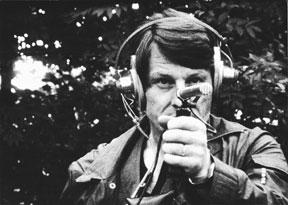
Zones
Grauzone- SWITZERLAND / 1979 / Swiss-German, German / B&W / 35mm / 99 min
Director, Script: Fredi M. Murer
Photography: Hans Liechti
Editing: Rainer Trinkler
Sound: Florian Eidenbenz
Music: Mario Beretta, Beo Œrtli
Art Director: Bernhard Sauter
Cast: Giovanni Früh, Olga Piazza
Production Companies: Lang Film, Nemo Film
Source: Swiss Films
This is Murer’s first feature-length narrative film. The 37-year-old Alfred M. works as a corporate secret agent, and his 33-year-old wife Julia works at an advertising agency. The film depicts the mysterious events that take place for the couple one weekend (from 5:00 p.m. on Friday to 12:30 p.m. on Monday). Mass media reports appear everywhere on radio and TV about a mysterious new epidemic, inspiring widespread anxiety. The “grey zone” (Grauzone is the original German title) refers to a state of helplessness, and might also point to the air space above Switzerland. The interests of the protagonists obviously lie in recording sounds with a tape recorder or looking into nearby apartments with a telescope. In this emphasizing of the characters’ attempts to know through vision and hearing, one can also identify themes that are common to many of Murer’s films.
Alpine Fire
Höhenfeuer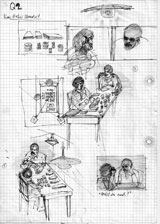
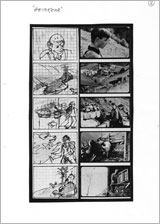
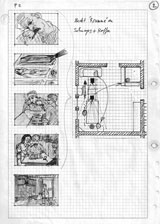
Storyboards for Alpine Fire
The Green Mountain
Der grüne Berg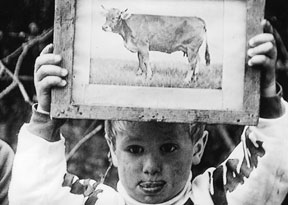 SWITZERLAND / 1990 / Swiss-German / Color / 16mm / 128 min
SWITZERLAND / 1990 / Swiss-German / Color / 16mm / 128 min
Director, Script: Fredi M. Murer
Photography: Pio Corradi
Editing: Kathrin Plüss
Sound: Florian Eidenbenz
Production Company: Bernhard Lang AG
Source: Swiss Films
This documentary film is part of the “mountain trilogy” alongside We Mountain People in the Mountains and Alpine Fire. In 1988, NAGRA (National Cooperative for the Disposal of Radioactive Waste) announced that it would construct a permanent waste disposal site in Wellenberg, Nidwalden, which spurned the creation of a protest group by local residents. Not only does Murer interview both those who support and those who oppose the construction, especially among the Alpine farmers who live in Wellenberg, he begins his approach to the issue by proposing the problem of the scale involved, which is greater than the time scale needed to measure human life. The research and debates all center around the people who will be directly impacted, namely the families who have lived in Wellenberg for many generations. They want to protect their roots since they are confronting a reality in which the earth on which they live might be stolen away from them at any moment. Murer dedicated this film to “the children, and the children of these children,” posing a cutting question to adults who must take responsibility for the next generation. In this sense, The Green Mountain can be thought of as a preview of Full Moon, which was produced eight years afterwards.
* The titles of works screened in this program are represented in bold.
1962 Marcel
1965 Pacific–or the Contented | Pazifik–oder die Zufriedenen
1965 Balance
1965 Sylvan
1966 Chicory | Chicorée
1966 Bernhard Luginbühl
1967 High | High and Heimkiller
1969 Sad-is-Fiction
1969 Vision of a Blind Man
1969 Swiss Made 2069 | 2069—oder dort, wo sich Futurologen und Archäologen gute Nacht sagen
1972 Passages | Passagen
1973 Christopher & Alexander
1974 We Mountain People in the Mountains | Wir Bergler in den Bergen sind eigentlich nicht schuld, dass wir da sind
1979 Zones | Grauzone
1985 Alpine Fire | Höhenfeuer
1987 Sehen mit anderen Augen | Seeing Through Other Eyes
1990 The Green Mountain | Der grüne Berg
1998 Full Moon | Vollmond
2004 Downtown Switzerland
2006 Vitus
2014 Liebe und Zufall | Love and Chance
